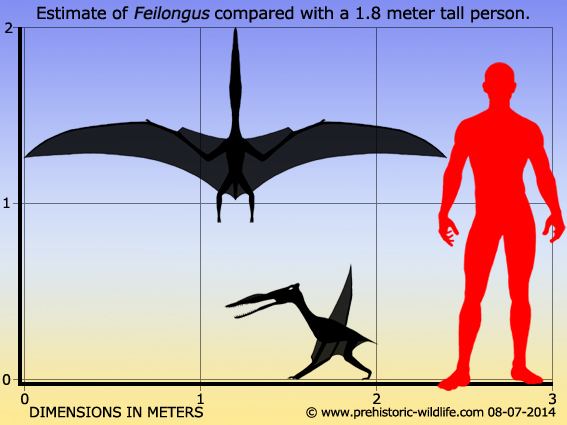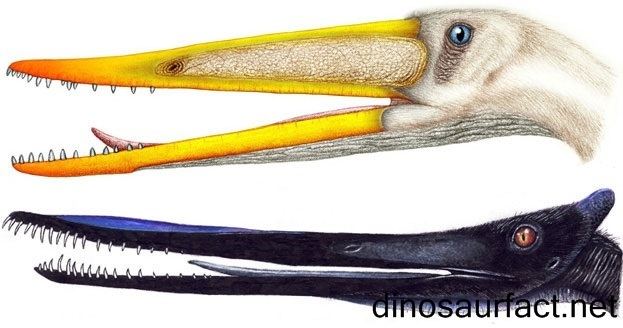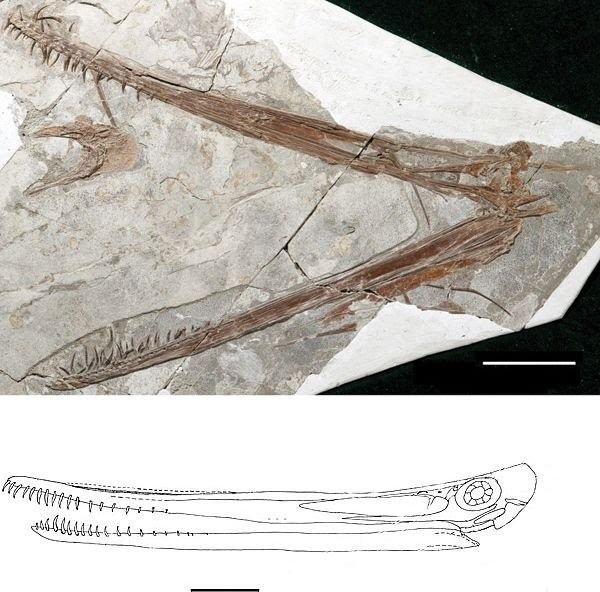Scientific name Feilongus youngi Rank Genus | Class Reptilia Subfamily †Gnathosaurinae Phylum Chordata | |
 | ||
Similar Nurhachius, Boreopterus, Haopterus, Eosipterus, Cycnorhamphus | ||
Feilongus is an extinct genus of ctenochasmatoid or ornithocheiroid pterodactyloid pterosaur from the Barremian-Aptian-age Lower Cretaceous Yixian Formation of Beipiao, Liaoning, China.
Contents

Description

The genus was named in 2005 by Wang Xiaolin e.a.. The type species is Feilongus youngi. The genus name is derived from Feilong, the "flying dragon". The specific name honours the late Chinese paleontologist Yang Zhongjian or "Chung Chien Young".

Feilongus is based on holotype IVPP V-12539, a skull and articulated mandible, with on the same plate the detached posterior braincase, of a subadult individual. The fossil is strongly crushed. It is notable for having two bony crests on the skull (one long and low on middle of the snout, and one projecting backwards from the rear of the skull), and for the upper jaws being 10% or 27 millimetres longer than the lower jaws, giving it a pronounced overbite. The preserved part of the second crest was short with the leading edge rounded, and may have had a nonbony extension, now lost. The skull of the only known individual is 390-400 millimeters long (15.4-15.7 inches) and extremely elongated with a slightly concave top. Its wingspan was estimated by Wang to have been around 2.4 meters (7.9 feet), making it large for a basal pterodactyloid. The skull and lower jaws held 76 long, curved needle-like teeth, eighteen in the upper, nineteen in the lower jaw, confined to the beak ends, the anterior third, of the jaws.
Classification

A cladistic analysis by the describers showed Feilongus as the sister taxon of a clade consisting of Gallodactylus and Cycnorhamphus, meaning it was a member of the Gallodactylidae sensu Kellner, a group of ctenochasmatoids, within the larger Archaeopterodactyloidea, the clade containing according to Alexander Kellner the most basal pterodactyloids. The Ctenochasmatoidea are known for having numerous small, thin teeth, possibly for straining food from water, as flamingos do today. However, in 2006 an analysis by Lü Junchang had as outcome that Feilongus was not an archaeopterodactyloid, but a member of the Ornithocheiroidea sensu Kellner, closer to the Anhangueridae. This means that using the alternative terminology of David Unwin they are close to the Ornithocheiroidea sensu Unwin, a group the members of which are typically more adapted to soaring and a piscivore, or fish-eating, diet. Another publication following this general line of thought has put Feilongus and Boreopterus into a new ornithocheiroid family, the Boreopteridae.


